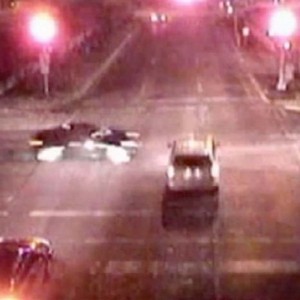As much as 12% of red light violations – equal to an annual total of 7.3 million stoplight infractions annually – are the result of distracted drivers, according to a new study.
Though the report doesn’t put a human toll on the problem in terms of crashes, injuries or accidents, some automotive safety experts have singled out red light running as the single leading cause of urban traffic accidents.
The research by the National Coalition for Safer Roads, or NCSR, and anti-distracted driving group FocusDriven tallies the results from stoplight camera images gathered at 118 intersections in 19 communities over a three-month timespan.
If the findings can be extrapolated on a nationwide scale that would suggest that distracted drivers run red lights more than 7.3 million times annually.
The Insurance Institute for Highway Safety contends that stoplight violations are the leading cause of accidents on crowded urban roads, and “The longer the light has been red when a violator enters an intersection, the more likely the driver is to encounter a vehicle traveling in another direction or a pedestrian,” according to Anne McCartt, the senior vice president of research at the IIHS.
The new study is likely to add more fuel to the fire as automotive safety advocates demand not only more regulations but also stricter enforcement of existing rules on distracted driving. Hawaii recently became the 40th state to enact such guidelines. They vary from state to state though most now bar texting while driving and the majority of those states have also put limits on the use of handheld phones.
There is an ongoing – and often vociferous – debate over the safety of hands-free calling.
According to FocusDriven and the NCSR, the new stoplight study shows that enforcement of distracted driving laws can have a major impact on red light running. In the communities covered by the research where authorities or more lenient – or where there are no rules at all – distracted driving accounted for 16% of stoplight violations. Where there was strict enforcement that fell to less than 10%.
(Separately, an IIHS study released earlier this year found that using automated camera systems to catch violators resulted in a 24% decline in fatal crashes caused by red light violations.
But there has been a significant amount of controversy over the technology by those who consider the technology a violation of rights or who feel they have been unfairly penalized.)
The National Coalition for Safer Roads and FocusDriven plan to launch a national multimedia campaign, dubbed “Stop Distraction on Red,” to raise awareness about the dangers of distracted driving and red light running.


…and the phone makers, phone companies and car makers are laughing all the way to the bank. Naturally local government, police, the healthcare, insurance and others are also cashing in on “distracted driving”. It’s a national disgrace.
Distracted driving is undeniably a serious issue. I wonder if we are not overlooking another serious distraction and that is NAV systems.
I can almost always tell when someone is using a NAV system as they begin to brake on the highway for no reason…except the NAV says take the next exit. Or when a road hits an intersection with other than a 90 degree intersection, they just freeze up.
I have even been using a NAV system myself when it commands, “continue the road for the next mile” just as you are approaching an intersection and it seems to implore you to go ahead irrespective of the color of the light! I realize it is my responsibility to observe the traffic laws while using my NAV, but following the commands becomes slightly hypnotic.
Certainly, the next generation of NAV systems should interact with traffic signals for an added level of safety.
This ‘study’ sounds like an insurance industry ploy to try and justify installation of red-light cameras, which produce increased revenue for municipalities and higher insurance rates for motorists. Impartial studies have shown that the true incidence of running red lights is pretty low, and could be reduced further by consistent timing of yellow lights (e.g., no “quick reds”). ‘Distracted’ driving is an ongoing problem that manifests itself in many ways besides running red lights (not staying in lanes, driving way over or under the speed limit, turning or stopping abruptly), but auto manufacturers contribute to this problem by promoting features that increase driver distraction.
Nav systems can definitely be a driver distraction, especially the ones that do not use voice commands with street names. If a driver needs to remove his eyes from the roadway to look at the display or to see what lane to be in for a turn or because the audible directions do not make it clear what street name to turn at, this can be a big problem.
The better portable auto GPS systems can be properly mounted to prevent the viewing issues and they also have proper street name commands. That however can’t compensate for unskilled drivers who not only can’t read a road map but also can’t drive an auto properly or safely. In the U.S. a driver’s license is a God given right so the state governments have determined.